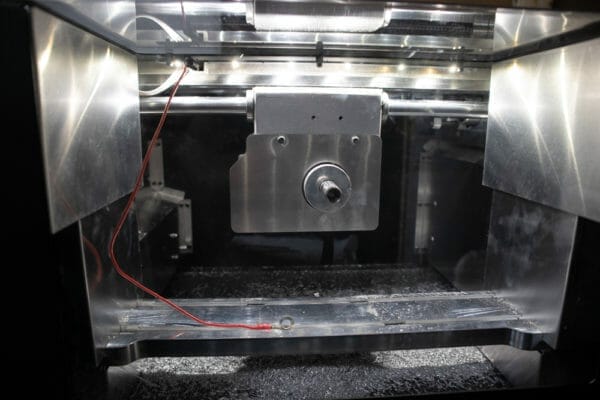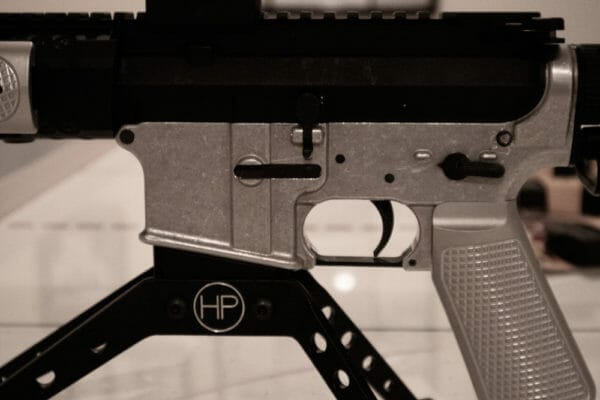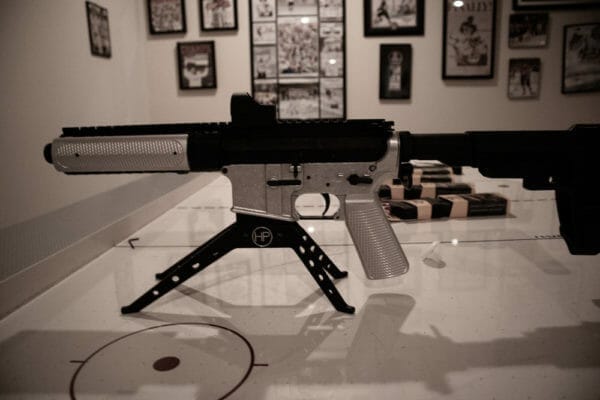BLUF:
To find out more about the Ghost Gunner and reserve their machine for a $500 deposit, readers can visit www.ghostgunner.net .
Ghost Gunner 3 CNC Machine – Defeating Gun Control One Cut at a Time
A couple of years ago, I tested out the Ghost Gunner 2 by Defense Distributed. The Ghost Gunner 2 was great for taking an 80% lower and turning it into a fully working firearm. In November of 2019 AmmoLand News reported the next GG3 would be a ground-up redesign. So when Cody Wilson of Defense Distributed gave me the chance to review their new Ghost Gunner 3 CNC machine, I couldn’t say no. Before we get into my review of the latest Ghost Gunner, we have to talk about what it does and why it is groundbreaking.
Ghost Gunner 3 CNC Machine
To put it simply, The Ghost Gunner is a purpose-built CNC machine that lets anyone turn an 80% lower receiver into a fully working firearm. Defense Distributed designed the Ghost Gunner not only to finish 80% AR15, AR10, AR9, and AR45 lowers, but it also complete 1911 and Polymer 80 frames. In 2021 they will be releasing a cutting code for an AKM. The operator doesn’t need to have any machine skills to use the Ghost Gunner.

The user connects any Mac or PC to the Ghost Gunner via an included USB cable. The user runs “DD Cut” and loads the correct cutting code for their project. The program will walk the user through using jigs (a 3D printer can print the jigs with the included files or purchase the jigs from the Ghost Gunner website if they do not have a 3D printer) to secure the lower receiver or firearm frame to the build platform. Then it is just a process of clicking next on the keyboard. The Ghost Gunner does the rest.
The user does have to reposition the lower or frame one time and switch out an end mill with a drill bit, but other than that, Defense Distributed designed the Ghost Gunner to be so easy anyone can do it. That is the whole point of the machine.
It isn’t so much of a way to finish a lower receiver into a functional firearm. It is a way of showing the feebleness of gun laws. Anyone who knows Cody Wilson knows he believes in no gun laws.
Defense Distributed is not to set up to make money. In fact, they are a non-profit. They are an educational institution. What they teach is that we can use technology like 3D printers and Ghost Gunners to defeat oppressive gun laws. Cody Wilson and Defense Distributed is the group behind the Liberator 3D printed pistol that caused the whole anti-gun world to freak out in 2013 when it first appeared.
Wilson and Defense Distributed horrified anti-gun politicians from coast to coast. They let the proverbial genie out of the bottle. Wilson is the father of the 3D printed firearms movement. Their pioneering spirit led to the rise of the home 3D gun printing movement. The company is fanatical in their support of not only the Second Amendment but also the First Amendment.
A couple of weeks after I agreed to review the Ghost Gunner 3 CNC Machine, it arrived on my doorstep. I opened the box, and the first thing I noticed was the Ghost Gunner 3 was a lot bigger than my old machine. It took a bit of work to get it out of the box because it is a lot heavier than the Ghost Gunner 2. Defense Distributed packaged the CNC machine well enough to make sure UPS wouldn’t damage it in transit.
The package included the Ghost Gunner 3 itself, all cabling to hook the machine up to a computer, wrenches to change the bits and end mills, and a USB drive with the DD Cut software and cutting codes. It doesn’t come with the drill bit, end mill, jigs, the two colletes, or all the screws and nuts. Since I had these from my Ghost Gunner 2, it didn’t bother me too much. If this is your first Ghost Gunner, you will have to put out a little more money to get up and running. Depending on what you are making, you can buy a kit from Defense Distributed for between $86 and $245.
The Ghost Gunner 3 CNC Machine is a massive improvement when compared to the earlier Ghost Gunner 2 machine. It is also bigger than any of my 3D printers. When unpacking the machine, I noticed a big red button on the side. The purpose of the switch is to reset the device if there is an emergency stop. The 1st machine version didn’t have a reset button, and the user had to reset it through software.
Another improvement is the chip shield. On the old Ghost Gunner, magnets held on the chip shield. Defense Distributed redesigned the Ghost Gunner 3 to have a slot where the chip shield attaches to the machine. Although I never had a problem with my old Ghost Gunner, this new method of securing the chip shield does seem safer.


One of the best changes to the Ghost Gunner is the probe. The probe is what allows the Ghost Gunner to know what it can cut. The probe connects to where the grip usually screws into the lower receiver. The probe on the original Ghost Gunner 2 was hard-wired into the machine. Defense Distributed made it so it can easily disconnect from the GG3 device. Now out of the way, it makes it easier to hook up a lower to begin the machining process.
Defense Distributed also included a small light built into the Ghost Gunner 3. Sometimes the contacts will get shorted out because of the build-up of aluminum shavings on the build plate. To check for a short, the users of a Ghost Gunner 2 would need a voltmeter. Now with the light, you just have to see if it off or on.
The lower receiver to be milled mounts to the Ghost Gunner 3 build plate precisely like the Ghost Gunner 2. I fired up the new software that Defense Distributed included in the box to see the difference. I noticed the software looks more complete than the software that came with the Ghost Gunner 2. That software looked like a beta. The new software looks like a final copy of the software.
I loaded the cut code for an AR15 receiver. It was straightforward to follow the step by step instructions. Every step included pictures. Anyone could mill out a lower receiver with no knowledge of machine work.
The Ghost Gunner 3 is a lot faster than the Ghost Gunner 2. I could mill out an AR15 lower receiver in less than 45 minutes. Users of the Ghost Gunner 2 will be happy to hear that the updated Ghost Gunner is five times faster than the old version. The speed makes a huge difference.
I installed a CMC lower parts kit into the receiver. I decided to make it a pistol AR, so I threw on an SB Tactical brace I had laying around. I used an Aero Precision pistol upper that I picked up a while ago and never did anything with it.

I kept the lower receiver raw aluminum and wanted to complete the look, so I picked up an Alumagrip grip and rails. Alumagrip had an option for a clear anodized finish and I decided to go with that.
I took my newly completed AR to the range and it ran flawlessly. Due to the ammo shortage, I only put 120 rounds through the firearm. It is unlikely that it will fail since it ran fine with the rounds I did fire. I will say I also really liked the Alumagrip products, they felt outstanding on the pistol.
The Ghost Gunner also can do other things. It is a fully functional CNC machine. It can do custom engraving and many other milling tasks. It is open-source software so anyone can design code for the device.
The Ghost Gunner is pricey. Defense Distributed sells it for $2,100. It will ship in the first quarter of 2021. The purpose of the Ghost Gunner 3 is more philosophical than anything else. It is about defeating gun control. That is the mission of Defense Distributed. The money that the Ghost Gunner 3 brings in to Defense Distributed helps them do stuff like sue in court freedom-of-speech-violators like New Jersey over its ban on 3D printed gun files.
The Ghost Gunner 2 felt like a beta. The Ghost Gunner 3 CNC Machine feels like a complete product and is a leap forward over the old model. My only complaint is that it will not work on an anodized 80% lower receiver.
To find out more about the Ghost Gunner and reserve their machine for a $500 deposit, readers can visit www.ghostgunner.net .

